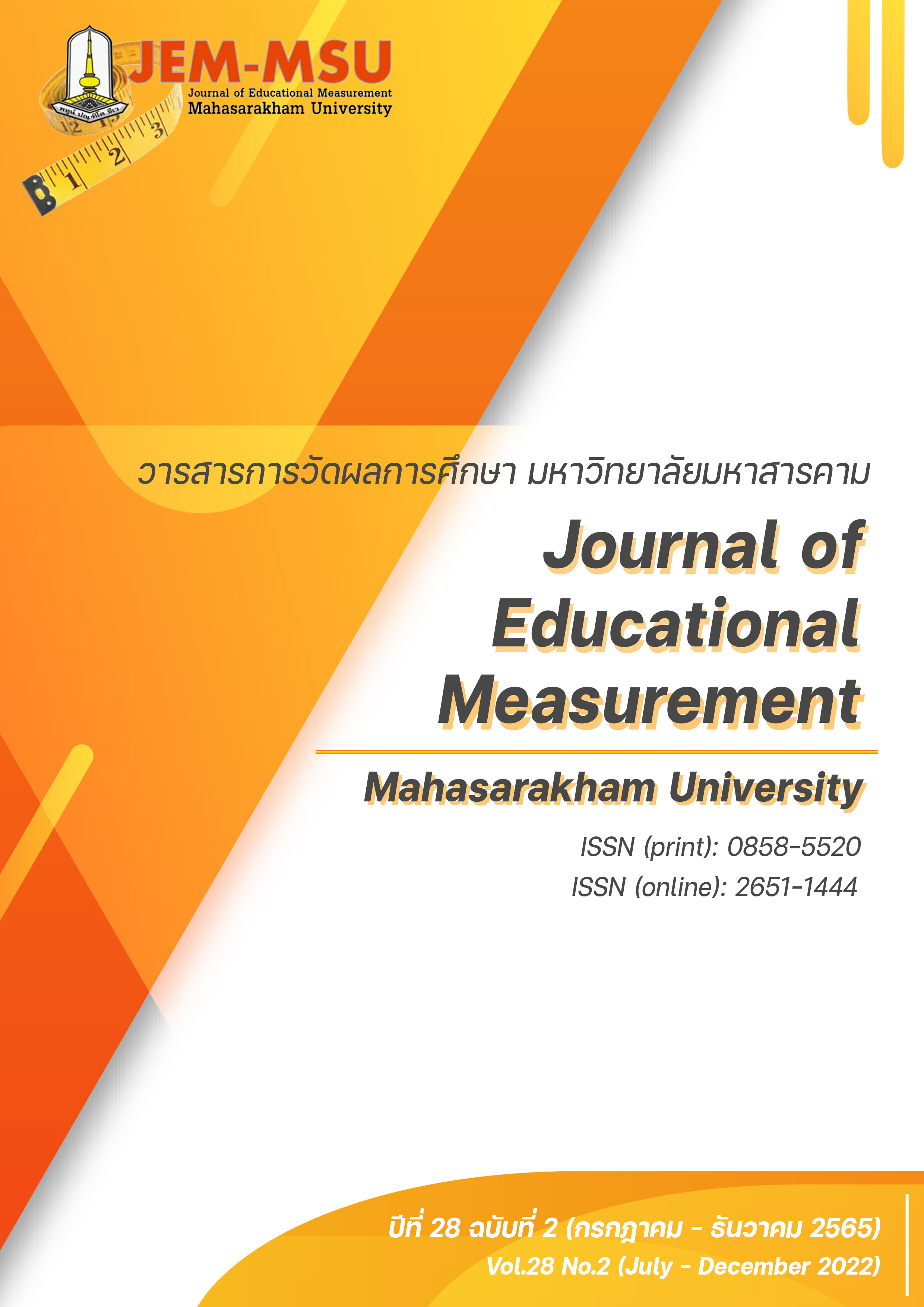การประเมินความต้องการจำเป็นในการพัฒนาสมรรถนะการสอนคิดตามแนวคิดโรงเรียนในฐานะชุมชนแห่งการเรียนรู้สำหรับครูโรงเรียนเอกชน จังหวัดเชียงใหม่
Main Article Content
บทคัดย่อ
การวิจัยนี้มีวัตถุประสงค์เพื่อศึกษาความต้องการจำเป็น ปัญหาและอุปสรรคในการพัฒนาสมรรถนะการสอนคิดของครูเอกชนด้วยกระบวนการพัฒนาบทเรียนร่วมกันผ่านชุมชนการเรียนรู้ทางวิชาชีพตามแนวคิดโรงเรียนในฐานะชุมชนแห่งการเรียนรู้ กลุ่มตัวอย่างที่ใช้ในการวิจัยครั้งนี้คือ ครูผู้สอนระดับมัธยมศึกษาตอนปลาย โรงเรียนเอกชน อำเภอเมือง จังหวัดเชียงใหม่ ปีการศึกษา 2563 จำนวน 251 คน โดยการสุ่มตัวอย่างแบบเป็นขั้นตอน (Multi-Stage random sampling) เครื่องมือที่ใช้ในงานวิจัยคือ แบบสอบถามแบบมาตราส่วนประเมินค่า 5 ระดับ สถิติที่ใช้ในการวิเคราะห์ข้อมูล ได้แก่ ความถี่ (f) ร้อยละ ค่าเฉลี่ย ( ) ส่วนเบี่ยงเบนมาตรฐาน (S.D.) การเรียงลำดับความสำคัญของข้อมูล (PNIModified) และการวิเคราะห์เนื้อหา
ผลการวิจัยพบว่า ครูระดับมัธยมศึกษาตอนปลายโรงเรียนเอกชนมีความต้องการจำเป็นในการพัฒนาสมรรถนะการสอนคิดให้นักเรียนสามารถใช้ความรู้ทางคณิตศาสตร์เพื่อประมวลผลได้เป็นอันดับแรก (PNIModified =0.32) รองลงมาคือการพัฒนาสมรรถนะการสอนคิดให้นักเรียนวิเคราะห์สาเหตุของปัญหาและกำหนดแนวทางการแก้ปัญหาได้อย่างมีประสิทธิภาพ (PNIModified =0.29) ตามมาด้วยการพัฒนาสมรรถนะ การสอนคิดให้นักเรียนมีความสามารถในการใช้ภาษาเพื่อถ่ายทอดความคิดออกมาให้ผู้อื่นรับทราบได้อย่างดี (PNIModified =0.26) และสมรรถนะด้านครูมีมนุษยสัมพันธ์ ควบคุมอารมณ์ได้ และรับฟังความคิดเห็นของผู้อื่นเป็นลำดับสุดท้าย (PNIModified =0.12) ครูเห็นความสำคัญการพัฒนาสมรรถนะการสอนคิดให้นักเรียนสามารถใช้ความรู้ทางคณิตศาสตร์ การวิเคราะห์สาเหตุของปัญหาและกำหนดแนวทางการแก้ปัญหาและความสามารถในการใช้ภาษาเพื่อถ่ายทอดความคิดออกมาให้ผู้อื่น ครูมีความต้องการให้มีการวิพากษ์ผลงานนวัตกรรมการเรียนการสอนเพื่อพัฒนางานให้มีประสิทธิภาพมากขึ้น ดำเนินกิจกรรมการเรียนรู้ผ่านการคิดอย่างเป็นระบบ คิดค้นสื่อการสอนที่หลากหลายเน้นการพัฒนาการคิดของนักเรียน และยังเห็นความสำคัญในการการพัฒนาสมรรถนะการสอนคิดโดยให้โรงเรียนนำการจัดการเรียนการสอนของโรงเรียนไปเผยแพร่ให้กับโรงเรียนอื่น ในจังหวัดเชียงใหม่ ปัญหาและอุปสรรคสำคัญในการพัฒนาสมรรถนะการสอนคิดครูขาดความรู้และ ความชำนาญในการปฏิบัติหน้าที่ ขาดทักษะและประสบการณ์ในการสอนคิด มีภาระงานมาก ขาดความร่วมมือจากนักเรียนและผู้ปกครอง รวมทั้งขาดระบบการบริหารจัดการที่ดี
Article Details

This work is licensed under a Creative Commons Attribution-NonCommercial-NoDerivatives 4.0 International License.
เนื้อหาและข้อมูลในบทความที่ลงตีพิมพ์ในวารสารการวัดผลการศึกษา มหาวิทยาลัยมหาสารคาม ถือเป็นข้อคิดเห็นและความรับผิดชอบของผู้เขียนบทความโดยตรง ซึ่งกองบรรณาธิการวารสาร ไม่จำเป็นต้องเห็นด้วย หรือร่วมรับผิดชอบใดๆ
บทความ ข้อมูล เนื้อหา รูปภาพ ฯลฯ ที่ได้รับการตีพิมพ์ในวารสารการวัดผลการศึกษา มหาวิทยาลัยมหาสารคาม ถือเป็นลิขสิทธิ์ของวารสารการวัดผลการศึกษา มหาวิทยาลัยมหาสารคาม หากบุคคลหรือหน่วยงานใดต้องการนำทั้งหมดหรือส่วนใดส่วนหนึ่งไปเผยแพร่ต่อหรือกระทำการใดๆ จะต้องได้รับอนุญาตเป็นลายลักษณ์อักษรจากวารสารการวัดผลการศึกษา มหาวิทยาลัยมหาสารคาม ก่อนเท่านั้น
References
Brookfield, S. D., & Brookfield, S. (1995). Becoming a critically reflective teacher. Jossey-Bass.
Darling-Hammond, L. (1999). Teacher quality and student achievement: A review of state policy evidence. Center for the Study of Teaching and Policy, University of Washington.
DuFour, R. (2007). Professional Learning Communities: A Bandwagon, an Idea Worth Considering, or Our Best Hope for High Levels of Learning?. Middle School Journal(J1), 39(1), 4-8.
Harari, Y. Noah. (2018). 21 Lessons for the 21st Century. Clays Ltd, Elcograf S.p.A.
Hord, S. M. (1997). Professional learning communities: Communities of continuous inquiry and improvement. Southwest Educational Development Laboratory.
Krejcie, R. V., & Morgan, D. W. (1970). Determining sample size for research activities. Educational and Psychological Measurement, 30(3), 607–610.
McClelland, C. David. (1973). Testing for Competence rather than for Intelligence. American Psychologist.
Seashore, K.R., Anderson, A.R. & Riedel, E. (2003). Implementing arts for Academic achievement: The impact of mental models, professional community and interdisciplinary teaming. Paper presented at the 17th Conference of the International Congress for School Effectiveness and Improvement, Rotterdam, January.
Torrance, E. P. & Myers, R. E. (1970). Creative Learning and Teaching. Dodd.
Chareonwongsak, K. (2013). Creative thinking. Success Media. (in Thai)
Chomphupart, S. (2011). A development of instructional behavior for the creative problem solving of teachers and students at the science gifted student’s promotion school using emancipatory action research [Doctoral Dissertation]. Srinakharinwirot University. (in Thai)
Kanchanachaya, N. (2016). Creative problems solving process instructional management. SDU Research Journal, 12(3), 207-224. (in Thai)
Khemmani, T. (2014). Bringing the teaching world to life for the new century classroom. Academic conference on productivity learning of the 21st century skills: Thinking process skills and social process skills. Office of Social Promotion of Learning and Youth Quality. (in Thai)
Manabu, S. (2016). School reform, the concept of “Learning Community” and the application from theory to practice. (Kulkanlaya Phusing, Translated). Parbpim Printing. (in Thai)
Office of Coordination and Promotion of the Private Education Commission, Chiang Mai Province. (2017). Private education quality development plan, Chiang Mai Province, Academic Year 2017 – 2021. (in Thai)
Office of the Education Council. (2019). Framework of Core Competency for Learners at Basic and Elementary Education Levels (P.1-3). 21 Century. (in Thai)
Office of the Education Council. (2020). State of Thai education B.E. 2561/2562 (A.D. 2018/2019) education reform in the digital era. Parbpim. (in Thai)
Panich, V. (2012). Ways to create learning for students in the 21st century. Tathata Publication Co., Ltd. (in Thai)
Phanlert, C. (2015). Mentoring in 9 ways to build teachers to students: a document of concepts and guidelines of professional development for teachers’ working group. Office of Social Promotion of Learning and Youth Quality. (in Thai)
Wongwanich, S. (2015). Needs assessment research. Chulalongkorn University Printing House. (in Thai)

